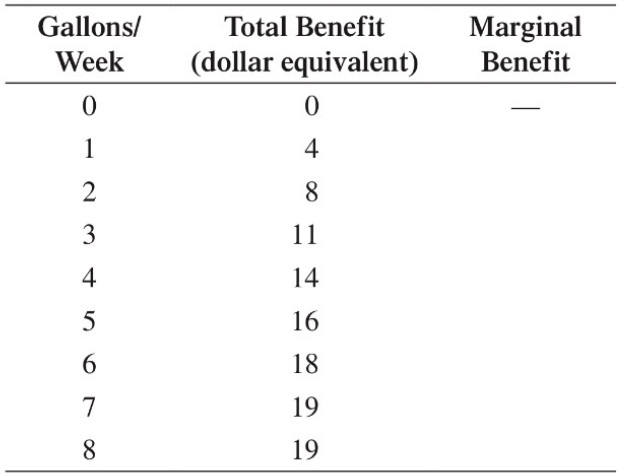Assignment:
1. Brazil is the world's largest coffee producer. There was a severe drought in Brazil in 2013-2014 that damaged Brazil's coffee crop. The price of coffee beans doubled during the first 3 months of 2014.
a. Draw and discuss a supply-and-demand diagram to explain the increase in coffee prices.
b. Are coffee and tea substitutes or complements? Explain.
c. What do you think the impact of this drought has been on the equilibrium price and quantity of tea? Draw a supply-and-demand diagram for the tea market to explain your answer.
2. Your total benefits from consuming different quantities of gas each week are shown in the following table:

a. Complete the marginal benefit column starting with the step from 0 gallons/week to 1 gallon/week.
b. The price of gasoline is $2.40/gallon. Use the Principle of Optimization at the Margin to find an optimal number of gallons of gas to consume each week.
c. Some policy makers have suggested taxing gasoline to reduce global warming. (Burning fossil fuels such as gasoline releases greenhouse gases, which are a cause of global warming.) Suppose the price of gasoline, including a gasoline tax, rises to $3.60/gallon.
Use the Principle of Optimization at the Margin to find an optimal number of gallons of gasoline, given this new tax-inclusive price of gasoline.
3. For each of the following situations, sketch the demand curve as accurately as possible.
a. Appendectomy is a life-saving operation that some people need. Regardless of the price, the quantity demand is 300,000 every year.
b. For any price above $5 absolutely nobody will buy your lemonade, but for any price below $5 you find that you are able to sell as much lemonade as you like.
c. There is only one buyer. For any price above $100 this buyer wants nothing. For any price at or below $100 this buyer wants exactly 20 units.
4. Land in Sonoma, California, can be used either to grow grapes for pinot noir wine or to grow Gravenstein apples.
The demand for pinot noir shifts sharply and permanently to the right. What will be the effect of the rightward shift in demand for pinot noir on the equilibrium price and quantity of Gravenstein apples?